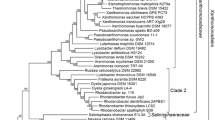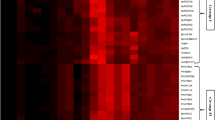Abstract
The PVC superphylum is a diverse group of prokaryotes that require stringent growth conditions. RNA is a fascinating molecule to find evolutionary relatedness according to the RNA World Hypothesis. We conducted tRNA gene analysis to find evolutionary relationships in the PVC phyla. The analysis of genomic data (P = 9, V = 4, C = 8) revealed that the number of tRNA genes varied from 28 to 90 in Planctomycetes and Chlamydia, respectively. Verrucomicrobia has whole genomes and the longest scaffold (3 + 1), with tRNA genes ranging from 49 to 53 in whole genomes and 4 in the longest scaffold. Most tRNAs in the E. coli genome clustered with homologs, but approximately 43% clustered with tRNAs encoding different amino acids. Planctomyces, Akkermansia, Isosphaera, and Chlamydia were similar to E. coli tRNAs. In a phylum, tRNAs coding for different amino acids clustered at a range of 8 to 10%. Further analysis of these tRNAs showed sequence similarity with Cyanobacteria, Proteobacteria, Viridiplantae, Ascomycota and Basidiomycota (Eukaryota). This indicates the possibility of horizontal gene transfer or, otherwise, a different origin of tRNA in PVC bacteria. Hence, this work proves its importance for determining evolutionary relatedness and potentially identifying bacteria using tRNA. Thus, the analysis of these tRNAs indicates that primitive RNA may have served as the genetic material of LUCA before being replaced by DNA. A quantitative analysis is required to test these possibilities that relate the evolutionary significance of tRNA to the origin of life.



Similar content being viewed by others
Data availability
All data generated or analysed during this study are included in this published article.
References
Alberts B, Johnson A, Lewis J, Raff M, Roberts K, Walter P (2002) Molecular biology of the cell, 4th edn. Garland Science, New York (ISBN-10: 0-8153-3218-1, 0-8153-4072-9)
Altschul SF, Gish W, Miller W, Myers EW, Lipman DJ (1990) Basic local alignment search tool. J Mol Biol 215:403–410
Athavale SS, Petrov AS, Hsiao C, Watkins D, Prickett CD, Gossett JJ, Lie L, Bowman JC, O’Neill E, Bernier CR, Hud NV, Wartell RM, Harvey SC (2012) RNA folding and catalysis mediated by iron (II). PLoS ONE 7(5):e38024. https://doi.org/10.1371/journal.pone.0038024
Boedeker C, Schuler M, Reintjes G, Jeske O, van Teeseling MCF, Jogler M, Rast P, Borchert D, Devos DP, Kucklick M, Schaffer M, Kolter R, van Niftrik L, Engelmann S, Amann R, Rohde M, Engelhardt H, Jogler C (2017) Determining the bacterial cell biology of Planctomycetes. Nat Commun 8:14853. https://doi.org/10.1038/ncomms14853
Bordin N, González-Sánchez JC, Devos DP (2018) PVCbase: an integrated web resource for the PVC bacterial proteomes. Database (oxford) 2018:bay042. https://doi.org/10.1093/database/bay042
Bowman JC, Lenz TK, Hud NV, Williams LD (2012) Cations in charge: magnesium ions in RNA folding and catalysis. Curr Opin Struct Biol 22:262–272. https://doi.org/10.1016/j.sbi.2012.04.006
Brown TA (2002) Genomes, 2nd edn. Oxford: Wiley-Liss; Chapter 7, Understanding a genome sequence. Available from: https://www.ncbi.nlm.nih.gov/books/NBK21136/. Accessed 23 Sept 2023
Budd A, Devos DP (2012) Evaluating the evolutionary origins of unexpected character distributions within the bacterial Planctomycetes−Verrucomicrobia−Chlamydiae superphylum. Front Microbiol 3:401. https://doi.org/10.3389/fmicb.2012.00401
Chan PP, Lowe TM (2019) tRNAscan-SE: searching for tRNA genes in genomic sequences. Methods Mol Biol 1962:1–14
Cooper GM (2000) The cell: a molecular approach, 2nd edn. Sinauer Associates, Sunderland (MA) (NCBI Bookshelf ID: NBK9841)
Crichton RR (2008) Iron: essential for almost all life. Biol Inorg Chem. https://doi.org/10.1016/B978-044452740-0.50013-2
Daffonchio D, Borin S, Frova G, Manachini PL, Sorlini C (1998) PCR fingerprinting of whole genomes: the spacers between the 16 s and 23 s rRNA genes and of intergenic tRNA gene regions reveal a different intraspecific genomic variability of Bacillus cereus and Bacillus licheniforrnis. Int J Syst Evol Microbiol 48:107–116. https://doi.org/10.1099/00207713-48-1-107
Devos DP, Jogler C, Fuerst JA (2013) The 1st EMBO workshop on PVC bacteria-Planctomycetes–Verrucomicrobia–Chlamydiae superphylum: exceptions to the bacterial definition? Antonie Van Leeuwenhoek 104:443–449. https://doi.org/10.1007/s10482-013-0026-y
Erlich Y, Zielinski D (2017) DNA Fountain enables a robust and efficient storage architecture. Science 355(6328):950–954. https://doi.org/10.1126/science.aaj2038
Forterre P (2015) The universal tree of life: an update. Front Microbiol 6:717. https://doi.org/10.3389/fmicb.2015.00717
Fuerst JA (2013) The PVC superphylum: exceptions to the bacterial definition?”. Antonie Van Leeuwenhoek 104(4):451–466. https://doi.org/10.1007/s10482-013-9986-1
Fujishima K, Kanai A (2014) tRNA gene diversity in the three domains of life. Front Genet 5:142. https://doi.org/10.3389/fgene.2014.00142
Giegé R (2008) Toward a more complete view of tRNA biology. Nat Struct Mol Biol 15(10):1007–1014. https://doi.org/10.1038/nsmb.1498
Gupta RS, Bhandari V, Naushad HS (2012) Molecular signatures for the PVC clade (Planctomycetes, Verrucomicrobia, Chlamydiae, and Lentisphaerae) of bacteria provide insights into their evolutionary relationships. Front Microbiol 3:327. https://doi.org/10.3389/fmicb.2012.00327
Gurtler V, Mayall BC (2001) Genomic approaches to typing, taxonomy and evolution of bacterial isolates. Int J Syst Evol Microbiol 51:3–16. https://doi.org/10.1099/00207713-51-1-3
Hazen RM, Papineau D, Leeker WB, Downs RT, Ferry JM, McCoy TJ, Sverjensky DA, Yang H (2008) Mineral evolution. Am Miner 93:1693–1720. https://doi.org/10.2138/am.2008.2955
Hud NV, Cafferty BJ, Krishnamurthy R, Williams LD (2013) The origin of RNA and “My grandfather’s axe.” Chem Biol 20:466–474. https://doi.org/10.1016/j.chembiol.2013.03.012
Hug LA, Baker BJ, Anantharaman K, Brown CT, Probst AJ, Castelle CJ, Butterfield CN, Hernsdorf AW, Amano Y, Ise K, Suzuki Y, Dudek N, Relman DA, Finstad KM, Amundson R, Thomas BC, Banfield JF (2016) A new view of the tree of life. Nat Microbiol 1:16048. https://doi.org/10.1038/nmicrobiol.2016.48
Joyce GF (1989) RNA evolution and the origin of life. Nature 338:217–224. https://doi.org/10.1038/338217a0
Katz A, Elgamal S, Rajkovic A, Ibba M (2016) Non-canonical roles of tRNAs and tRNA mimics in bacterial cell biology. Mol Microbiol 101(4):545–558. https://doi.org/10.1111/mmi.13419
Kim Y, Kowiatek B, Opron K, Burton ZF (2018) Type-II tRNAs and evolution of translation systems and the genetic code. Int J Mol Sci 19:3275. https://doi.org/10.3390/ijms19103275
Kim Y, Opron K, Burton ZF (2019) A tRNA- and anticodon-centric view of the evolution of aminoacyl-tRNA synthetases, tRNAomes, and the genetic Code. Life 9(2):37. https://doi.org/10.3390/life9020037
Kumar S, Nei M, Dudley J, Tamura K (2008) MEGA: a biologist-centric software for evolutionary analysis of DNA and protein sequences. Brief Bioinform 9(4):299–306. https://doi.org/10.1093/bib/bbn017
Lagkouvardos I, Jehl MA, Rattei T, Horn M (2014) Signature protein of the PVC superphylum. Appl Environ Microbiol 80(2):440–445. https://doi.org/10.1128/AEM.02655-13
Lee KC, Webb RI, Janssen PH, Sangwan P, Romeo T, Staley JT, Fuerst JA (2009) Phylum Verrucomicrobia representatives share a compartmentalized cell plan with members of bacterial phylum Planctomycetes. BMC Microbiol 9:5. https://doi.org/10.1186/1471-2180-9-5
Lonhiennea TGA, Sagulenko E, Webb RI, Lee KC, Franke J, Devose DP, Nouwens A, Carroll BJ, Fuerst JA (2010) Endocytosis-like protein uptake in the bacterium Gemmata obscuriglobus. PNAS 107:12883–12888. https://doi.org/10.1073/pnas.1001085107
Lowe TM, Chan PP (2016) tRNAscan-SE on-line: search and contextual analysis of transfer RNA genes. Nucleic Acids Res 44:W54-57
Mansuripur M (2002) DNA, human memory, and the storage technology of the 21st century. In: T. Hurst, & S. Kobayashi (Eds) Proceedings of SPIE - The International Society for Optical Engineering (Vol. 4342, pp. 1–29). https://doi.org/10.1117/12.453368
O’Donoghue P, Luthey-Schulten Z (2003) On the evolution of structure in aminoacyl-tRNA synthetases. Microbiol Mol Biol Rev 67:550–573. https://doi.org/10.1128/MMBR.67.4.550-573.2003
Oakeson KF, Wagner JM, Mendenhall M, Rohrwasser A, Atkinson-Dunn R (2017) Bioinformatic analyses of whole-genome sequence data in a public health laboratory. Emerg Infect Dis 23(9):1441–1445. https://doi.org/10.3201/eid2309.170416
Outten FW, Theil EC (2009) Iron-based redox switches in biology. Antioxid Redox Signal 11:1029–1046. https://doi.org/10.1089/ars.2008.2296
Pak D, Root-Bernstein R, Burton ZF (2017) tRNA structure and evolution and standardization to the three nucleotide genetic code. Transcription 8(4):205–219. https://doi.org/10.1080/21541264.2017.1318811
Pinos S, Pontarotti P, Raoult D, Baudoin JP, Pagnier I (2016) Compartmentalization in PVC superphylum: evolution and impact. Biol Direct 11:38. https://doi.org/10.1186/s13062-016-0144-3
Pressman A, Blanco C, Chen IA (2015) The RNA world as a model system to study the origin of life. Curr Biol 25(19):R953-963. https://doi.org/10.1016/j.cub.2015.06.016
Rivas-Marín E, Devos DP (2018) The paradigms they are a-changin’: past, present and future of PVC bacteria research. Antonie Van Leeuwenhoek 111(6):785–799. https://doi.org/10.1007/s10482-017-0962-z
Rivas-Marín E, Canosa I, Devos DP (2016) Evolutionary cell biology of division mode in the bacterial Planctomycetes-Verrucomicrobia-Chlamydiae superphylum. Front Microbiol 7:1964. https://doi.org/10.3389/fmicb.2016.01964
Root-Bernstein R, Kimb Y, Sanjay A, Burton ZF (2016) tRNA evolution from the proto-tRNA minihelix world. Transcription 7(5):153–163. https://doi.org/10.1080/21541264.2016.1235527
Scriven M (1959) Explanation and prediction in evolutionary theory. Science 130(3374):477–482. https://doi.org/10.1126/science.130.3374.477
Smith TF, Hartman H (2015) The evolution of class II aminoacyl-tRNA synthetases and the first code. FEBS Lett 589:3499–3507. https://doi.org/10.1016/j.febslet.2015.10.006
Staley JT (2017) Domain cell theory supports the independent evolution of the eukarya, bacteria and archaea and the nuclear compartment commonality hypothesis. Open Biol 7:170041. https://doi.org/10.1098/rsob.170041
van Niftrik L, Devos DP (2017) Editorial: Planctomycetes-Verrucomicrobia-Chlamydiae bacterial superphylum: new model organisms for evolutionary cell biology. Front Microbiol 8:1458. https://doi.org/10.3389/fmicb.2017.01458
WagnerM HM (2006) The Planctomycetes, Verrucomicrobia, Chlamydiae and sister phyla comprise a superphylum with biotechnological and medical relevance. Curr Opin Biotechnol 17(3):241–249. https://doi.org/10.1016/j.copbio.2006.05.005
Weiss MC, Sousa FL, Mrnjavac N, Neukirchen S, Roettger M, Nelson-Sathi S, Martin MF (2016) The physiology and habitat of the last universal common ancestor. Nat Microbiol 1:16116. https://doi.org/10.1038/nmicrobiol.2016.116
Williams MB (1982) The importance of prediction testing in evolutionary biology. Erkenntnis 17:291. https://doi.org/10.1007/BF00182671
Williamson PO, Minter CIJ (2019) Exploring PubMed as a reliable resource for scholarly communications services. J Med Libr Assoc 107(1):16–29. https://doi.org/10.5195/jmla.2019.433
Wolf YI, Koonin EV (2007) On the origin of the translation system and the genetic code in the RNA world by means of natural selection, exaptation, and subfunctionalization. Biol Direct 2:14. https://doi.org/10.1186/1745-6150-2-14
Wong JTF, Ng SK, Mat WK, Hu T, Xue H (2016) Coevolution theory of the genetic code at age forty: pathway to translation and synthetic life. Life 6(1):12. https://doi.org/10.3390/life6010012
Acknowledgements
BR duly acknowledges the grant received from the University Grants Commission, New Delhi, India (Letter no. PDFSS-2013-14-ST-MAH-4350).
Funding
This article is funded by University Grants Commission, PDFSS-2013-14-ST-MAH-4350.
Author information
Authors and Affiliations
Contributions
BNR: conceptualization, methodology, validation, formal analysis, investigation, data curation, visualization, writing - original draft, writing - review and editing. YSS and KJ: supervision, resources, methodology, project administration, writing - review and editing. All authors have reviewed and finalized this manuscript.
Corresponding author
Ethics declarations
Conflict of interest
The authors declare no competing interests.
Additional information
Communicated by Yusuf Akhter.
Publisher's Note
Springer Nature remains neutral with regard to jurisdictional claims in published maps and institutional affiliations.
Rights and permissions
Springer Nature or its licensor (e.g. a society or other partner) holds exclusive rights to this article under a publishing agreement with the author(s) or other rightsholder(s); author self-archiving of the accepted manuscript version of this article is solely governed by the terms of such publishing agreement and applicable law.
About this article
Cite this article
Rekadwad, B.N., Shouche, Y.S. & Jangid, K. Investigation of tRNA-based relatedness within the Planctomycetes−Verrucomicrobia−Chlamydiae (PVC) superphylum: a comparative analysis. Arch Microbiol 205, 366 (2023). https://doi.org/10.1007/s00203-023-03694-7
Received:
Revised:
Accepted:
Published:
DOI: https://doi.org/10.1007/s00203-023-03694-7




